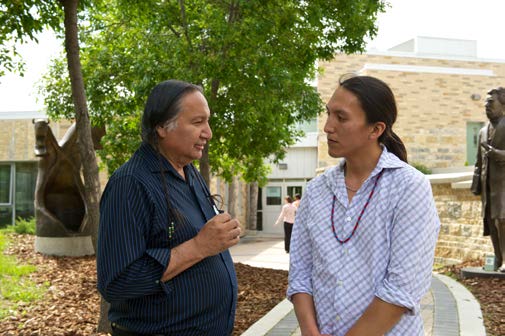Indigenization of the Campus

One of the key considerations for the Plan is the Indigenization of the Campus. Brandon University continues to embrace the opportunity to inclusively and collaboratively engage with its Indigenous community and aims to provide a strong sense of belonging and identity within the Campus by various means. The Campus Master Plan considers the following as key guiding principles to this end. In addition, the Plan has identified a series of Indigenous Placemaking Initiatives that are infused in the Concept Plan Vision.
Design Principles
Foster an Indigenous sense of place.
The Campus Master Plan Frameworks structures the design of the physical campus to provide many opportunities for Indigenous placemaking, and telling the Indigenous story on campus.
Commit to listening.
Through the campus planning process and the implementation of the Campus Master Plan, the voices of Indigenous people must be heard and recognized.
Build Indigenous identity.
Reflect an Indigenous face to the community — at significant gateway points on campus and throughout the Campus — through building and open space design, as gateway and wayfinding signage, through permanent or temporary art, or integrated in furniture.
Respect and enhance the land.
Upgrade existing open spaces and streetscapes by increasing tree planting and landscaping, incorporating sustainable design, integrating water features, enhancing plant and animal habitat, and planting food producing trees and gardens on the Campus.
Represent Indigenous culture and teaching.
This could be done, among other things, through dedication and design of spaces within the Campus that nurture a curriculum and learning approaches relevant to Indigenous epistemologies in respectful research methodologies and ethics protocols. For example, there are opportunities to teach and learn about plant systems, animal habitat, food production, and medicine, with places for ceremonial planting, for ceremony and smudging, for cultural festivals and activities.
Recognize Indigenous history and cultural heritage.
All aspects of the Campus should commit to the recognition of Indigenous peoples’ traditional territory and continued use of the land, while identifying the Campus as being located within an environment and place connected with Indigenous peoples’ history and communities, and home to many Indigenous learners.
Support Indigenous programming and student life.
Continue to build welcoming and respectful environments on the Campus through the implementation of academic programs and spaces, services, and support mechanisms dedicated to Indigenous students. Recognize the importance of sharing information within the institution and beyond to inform current and prospective students of the array of services, programs, and supports available to them on the Campus.
Support cross-cultural learning.
This should be done by enabling resources, spaces, and approaches that engage students, staff, and faculty in experiencing Indigenous people’s knowledge and cultural heritage in holistic and respectful ways. Flexible design of the physical campus can help create welcoming places for all, and destinations on campus from which to draw the outside interest. Recognize opportunities for promotion, reclamation, restoration, revitalization, and awareness of Indigenous languages throughout the Campus.
Support the wellbeing of Indigenous peoples as a whole.
Support, promote, celebrate and record all Indigenous initiatives at Brandon University, through institutional platforms and the implementation of Indigenizing initiatives dedicated to the wellbeing of Indigenous peoples as a whole.
Indigenous Placemaking Initiatives
The Campus Master Plan Frameworks structures the design of the physical campus to provide many opportunities for Indigenous placemaking, and telling the story of Indigenous peoples. The following are physical interventions that can be undertaken throughout the implementation of the Plan to continue to enhance the Indigenization of the Campus.
Building Indigenous Identity
Building Indigenous identity can be done by reflecting an Indigenous face to the community:
- at significant gateway points on campus and throughout the campus;
- through building and open space design;
- as gateway and wayfinding signage; and,
- through permanent or temporary art, or art integrated in furniture.
Respect for and Enhancement of the Land
This can be done through open space and streetscape design by:
- increasing tree planting and landscaping;
- incorporating sustainable design;
- integrating water features;
- enhancing plant and animal habitat; and,
- planting food producing trees and gardens on campus.
Representing Culture and Teaching
This can be done through landscaping and pedagogical design:
- through opportunities to teach and learn about plant systems, animal habitat, food production, and medicine; and,
- by providing places for ceremonial planting, for ceremony and smudging, and for cultural festivals and activities.
Fostering Community and Inclusiveness
This can be undertaken through flexible design of the physical campus to
- create welcoming places for all, and
- create internal and external social places and destinations for the community, and to draw the Indigenous community in.
